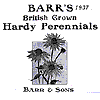Kortmann (1998)
officinalis 'Rubra Plena' (vóór 1907) Bloemen intensief donkerrood, gevuld; bladeren lichtgroen, blaadjes soms iets ingesneden; hoogte 50 cm; bloemstengels matig stevig; vertakking redelijk tot goed. 'Rubra Plena' is typisch een pioen voor de min. Voor de snij is deze cultivar minder geschikt. De plant bloeit rijk en heeft een mooie intensief rode kleur. Helaas is ook deze boerenpioen ietwat Botrytis gevoelig.
listed by:
'Rubra Plena' ,**,B,1-3/ 70-80,80,s. früh ,tiefkarminrot,C2,Bekannte "Bauerngarten -Pfingstrose".
RUBRA PLENA (Double) "L'ivrogne". Quel vilain nom pour une si belle plante I C'est pourtant celui qu'on lui réservait autrefois Elle mérite beaucoup mieux. Sa fleur rouge vif très soutenu, son feuillage abondant et très foncé, sa vigueur, l'autorisent à prendre place parmi les meilleures. H. 0,6 m.
OFFICINALIS 'RUBRA PLENA':The Red Memorial Day Peony of intense red has been cultivated for centuries in Europe. A true living antique that is of great garden value today. Very early.
OFFICINALIS RUBRA PLENA (E) Deep red double, a species known to Europeans since the middle ages; in the U.S. it's known as the Memorial Day Peony; one of the essentials carried out west in the covered wagons, probably snuck in so Pa wouldn't mind,
officinalis Rubra plena Double deepest crimson flowers with little rosettes of frilly petals. A full and luxurious bloom and the traditional cottage peony. Scented. Early.
OFFICINALIS RUBRA PLENA Pink, Double, Early, No staking. 80cm. Very hardy, strong and compact. The reliable old fashioned double peony in dark red.
OFFICINALIS RUBRA PLENA When folk come into our nursery and tell us about the double red peony that they remembered in their grandmother's garden, and ask do we have it, we immediately think of this one. Very well known, and just as popular today as it ever has been. It is widely used in the hybridising of many of the modern peonies. Very hardy, strong and compact. Red Double, Early, 80cm.
officinalis var. rubra-plena ("Old Double Crimson"), reddish-purple with garnet-purple and carmine-purple shades.
RUBRA PLENA, Origine onbekend, vóór 1907, Paeonia officinalis, Geheel gevulde bloemen, intensief donkerrood. Qua bloemvorm sprekend gelijkend op ‘Rosea Plena’. Geen zijknoppen. Een zeer oude pioen, officieuze bronnen verwijzen naar een origine zover terug als de 17e eeuw. Dé boerenpioen – een term die velen bekend in de oren klinkt. Deze eeuwig populaire pioen was vroeger veel te vinden langs het erf van menig boerderij en aldus is ze liefkozend vernoemd. Niet weg te denken uit welk pioenenassortiment dan ook
RUBRA PLENA, Origin unknown, before 1907, Paeonia officinalis, Full double flowers, of an intense red color. Same flower form as 'Rosea Plena'. No sidebuds. Also known as the 'Memorial Day Peony' or the traditional cottage peony. An ever-popular peony seen spotted quite frequently alongside old farm properties. 'Rubra Plena' is an ancient cultivar, supposively dating back as far as the 17th century. A true living antique that is of great garden value today still.

- Außenreihe/ outer row
outer side
inner side
Mittelreihe/ Middle row
outer side
inner side
Innenreihe/ inner row
outer side
inner side
Upper surface/Oberseite
Lower surface/Unterseite
- Autumn/Herbst


peregrina/officinalis cultivar
Die genaue Zuordnung von Staudenpfingstrosen dieser Gruppe ist insofern problematisch, daß viele im 20. Jahrhundert als „Paeonia officinalis“-Kultivare bezeichnete Sorten eigentlich Abkömmlinge von Paeonia peregrina sind. Bis in die 1930er Jahre hießen auch die Peregrinas alle Paeonia officinalis. Ich bezweifle, daß ein Großteil dieser Gruppe irgendetwas mit Paeonia officinalis zu tun hat, angefangen bei der allseits bekannten Bauernpfingstrose „Officinalis Rubra Plena“, die entweder ein Kultivar von Paeonia peregrina ist oder (wahrscheinlicher) eine Hybride aus Paeonia peregrina und einer anderen Wildart, vielleicht Paeonia officinalis. Um dieses Zuordnungsproblem zu umgehen, hier die Gruppe „p/o“: Sorten, die im Wuchs, Blütenstellung, Laub und Farbe Paeonia peregrina ähneln bzw. Paeonia 'Officinalis Rubra Plena'. Die Zuordnung zu den Hybriden erfolgt wegen der bestehenden Unsicherheiten nicht.
Peonies, The Manual of the American Peony Society, edited by James Boyd © 1928 American Peony Society:
P. officinalis. Southern Europe. This species has been cultivated in European gardens for centuries, and has given rise to a number of. brilliant and lovely varieties. There is much confusion regarding those which are to be traced back to P. officinalis and those derived from P. paradoxa.
Vilmorin ("Fleurs de Pleine Terre") separates two groups under these two specific names; and he states that those derived from P. paradoxa are easily distinguished by the glaucescence (bluish greenness) of the foliage. Unfortunately, Vilmorin does not include in nis list by any means all of the varieties which are, or have been, in commerce.
Since these forms when offered in nurserymen's lists are usually grouped all together under P. officinalis, I have listed them all here, making a separate group of those which, according to Vilmorin, should be referred to P. paradoxa.
A further complication arises from the fact that several varieties have been produced from P. lobata. This is itself to be considered as a variety of P. officinalis, and it is not always possible in the case of named varieties to say whether they should be referred to P. lobata or to the broader species P. officinalis.
Varieties probably referable to P.officinalis:
alba mutabilis
alba plena
atrorubra plena
anemoneflora
blanda
carnea plena. Syn. alba mutabilis
carnescens
Ceres
Charmer
Eclair. Syn. alba mutabilis
Fire King
fulgens
incarnata plena. Syn. alba mutabilis
Lize van Veen. Sport from P. rosea superba, which has been recently introduced into commerce in Holland.
lobata : Otto Froebel, Sunbeam
maxima rosea plena
Ophia
Oriflamme
purpurea plena
rosea (single)
rosea pallida plena. Syn. alba mutabilis
rosea plena
rosea superba plena (rated 8.2 in symposium, 1925)
rubra plena (rated 8.6 in symposium, 1925)
Sabini
sanguinea plena
splendens
striata elegans
The Sultan














































